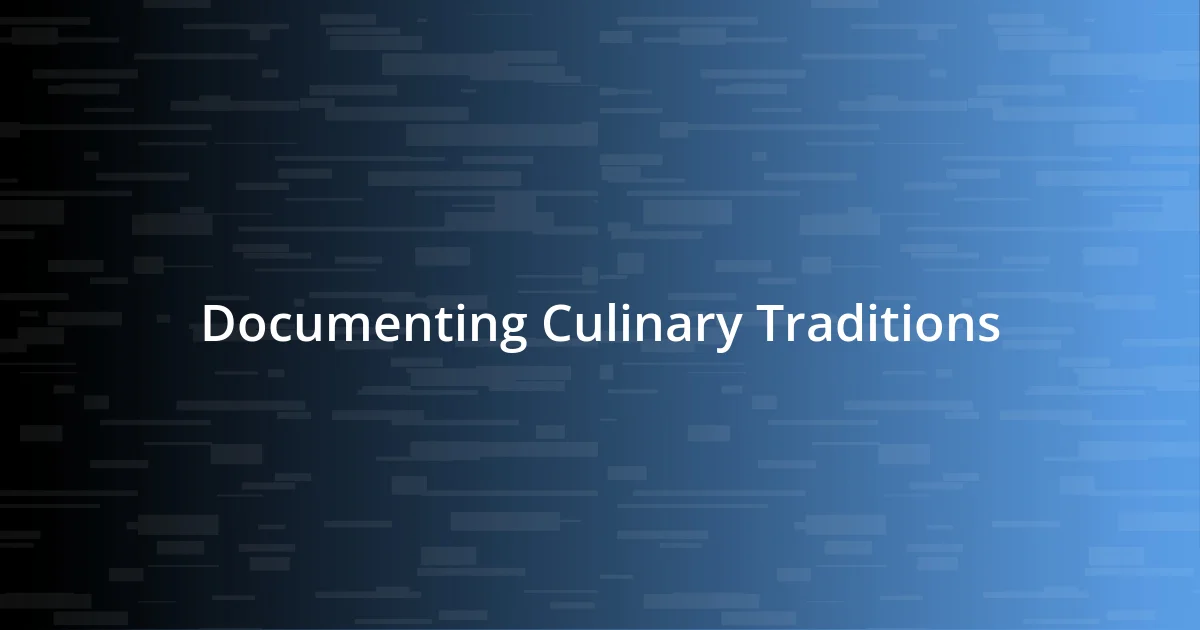Key takeaways:
- Culinary heritage connects us to our past, reflecting cultural identities and fostering a sense of belonging through shared meals and traditions.
- Engaging with local communities, through activities like farmers’ markets and cultural festivals, deepens our understanding of culinary practices and their historical significance.
- Experimenting with recipes allows for personal creativity, transforming traditional dishes into individual expressions while preserving their cultural essence.

Understanding Culinary Heritage
Culinary heritage is not just about recipes; it’s a tapestry woven from memories, traditions, and cultural identities. I remember the warm, inviting aroma of my grandmother’s kitchen, where every dish told a story. Have you ever noticed how a single bite can transport you back to a cherished moment?
When I think about the importance of culinary heritage, it strikes me how it reflects our history and values. Each ingredient we use has its own background, often linked to regional agriculture, migration, and celebration. Isn’t it fascinating how a dish can connect us to our ancestors and their way of life?
Exploring culinary heritage invites us to examine why we eat what we eat, which can stir deep emotions. I recall sitting around the table during family gatherings, where certain dishes sparked conversations about family roots and cultural pride. Have you experienced a meal that made you feel a sense of belonging? It’s these moments that show how food acts as a bridge across generations, helping us understand ourselves and our place in the world.

Importance of Culinary Exploration
The beauty of culinary exploration lies in its power to preserve and celebrate cultural identities. I vividly remember attending a local food festival where each stall represented a different tradition, each bite bursting with the essence of its origin. Can you feel the excitement of discovering a dish that resonates with your own background? This celebration fosters a sense of community and belonging, bridging gaps between generations and cultures.
Furthermore, diving into culinary heritage can illuminate the environmental practices of our ancestors. I once tried a dish made from ingredients foraged from a nearby forest, and it made me reflect on how my ancestors might have thrived sustainably. It’s remarkable how these age-old practices can guide us toward a more environmentally responsible future. Have you ever considered how our eating habits can impact the planet?
Ultimately, culinary exploration enriches our lives by encouraging creativity and innovation. I often experiment with traditional recipes, infusing them with modern twists that reflect my personal journey. This not only honors the past but also allows me to create new memories to share with others. Isn’t it thrilling to think about the legacy we create with every dish we prepare?
| Aspect | Importance |
|---|---|
| Cultural Identity | Preserves and celebrates unique traditions and backgrounds. |
| Environmental Awareness | Sheds light on sustainable practices of previous generations. |
| Creativity and Innovation | Encourages personal interpretation and modern adaptations of traditional dishes. |

Methods of Researching Food History
Researching food history can be a captivating adventure. I find that diving into cookbooks from different eras gives me an authentic glimpse of culinary practices and tastes of the past. One time, while studying a vintage cookbook, I stumbled upon a recipe for a dish my great-grandfather used to make. The joy of re-creating it felt like a momentary time travel, bridging our family legacy and the present.
The methods I find effective in this research journey include:
- Exploring historical cookbooks: These often offer insights into ingredients and techniques relevant to specific periods.
- Conducting interviews: I’ve spoken with elders in my community, who often share personal stories tied to traditional recipes, enriching my understanding of their significance.
- Visiting food museums: These spaces showcase artifacts and narratives that capture the essence of culinary evolution.
- Analyzing regional food practices: Observing how local ingredients shape dishes can reveal much about the culture and environment.
- Utilizing online resources: I often dig into archives and digital collections, discovering recipes and food history documented by scholars and enthusiasts alike.
There’s so much to uncover, and each method opens up a new layer of connection to my culinary past.

Engaging with Local Communities
One of the most rewarding experiences I’ve had in engaging with local communities was when I volunteered at a community kitchen. It was fascinating to see how neighbors came together to share their favorite family recipes, turning a simple meal into a warm gathering of stories and traditions. Have you ever participated in something that made you feel so connected to others? I certainly did, as each dish served was accompanied by laughter, memories, and a sense of belonging that nourished us all.
Additionally, I’ve found farmers’ markets to be an incredible way to dive into local culinary culture. I remember speaking with a farmer about a rare heirloom vegetable he grows. It wasn’t just about the produce; it was about preserving the farming practices passed down through generations. Isn’t it enlightening to consider how food is not only sustenance but also a bridge to our past? Each interaction at the market felt like peeling back layers of history, showing how deeply intertwined our food systems are with local communities.
Visiting cultural festivals has also been a fantastic avenue for engaging with the richness of local culinary heritage. One year, I attended a cultural fair that showcased traditional music, dance, and food from various ethnic groups. Tasting a dish prepared right in front of me, along with hearing the stories behind it, truly made me appreciate the vibrant tapestry of flavors and traditions. Have you ever tasted something that made you reflect on cultural heritage? For me, it was a delicious reminder that every bite holds a story worth sharing.

Documenting Culinary Traditions
Documenting culinary traditions has been a journey of discovery for me. Once, while digitizing family recipes handed down from my grandmother, I could almost hear her voice guiding me through her kitchen, her laughter echoing with each step as I typed. It was more than just preserving the recipes; it was about capturing her spirit and the memories those dishes evoked. Does anyone else feel that pull when revisiting family cuisine?
I also enjoy creating a visual diary of the culinary traditions I encounter. My experience photographing local cooking classes was enlightening; each image told a story. As I snapped pictures of vibrant ingredients and enthusiastic chefs, I realized how documenting these culinary moments connects generations of cooks. Have you ever thought of how a simple photo could carry the weight of history?
When I spoke with a local historian about food customs, I felt the depth of our shared culture. He passionately described how traditional methods have evolved, highlighting how each dish reflects the values and experiences of the community. This conversation reminded me that documenting culinary traditions isn’t just about the food itself—it’s about understanding our shared human experience. It makes me wonder: What culinary stories do you carry that deserve to be shared?

Cooking and Experimenting with Recipes
Cooking and experimenting with recipes has become a thrilling part of my culinary journey. I remember one weekend when I decided to make a traditional dish from scratch—something I’d only ever tasted before. As I mixed ingredients and adjusted spices, I felt an overwhelming sense of connection to its origins. Have you ever felt that rush of creativity while cooking? For me, it’s like uncovering a hidden part of myself through flavors and techniques.
I find that each recipe I try teaches me more than just cooking skills. Recently, I attempted a complex dish that my friend raved about. I was surprised by how my small tweaks led to unexpected flavors. It was a light bulb moment! It’s amazing how cooking can be both a science and an art, where the smallest adjustments can completely change the outcome. What’s a recipe you’ve personalized that surprised you with its results?
Experimentation often leads to delicious serendipity. One time, I was low on ingredients but didn’t want to give up on dinner. So, I used what I had on hand to create a fusion dish that blended two cultures. The end result was a surprising hit among my family and friends! It taught me that culinary adventures can arise from constraints as much as from abundance. Have you ever turned a cooking challenge into a delightful surprise? I think that’s what makes cooking an endlessly fascinating pursuit.














